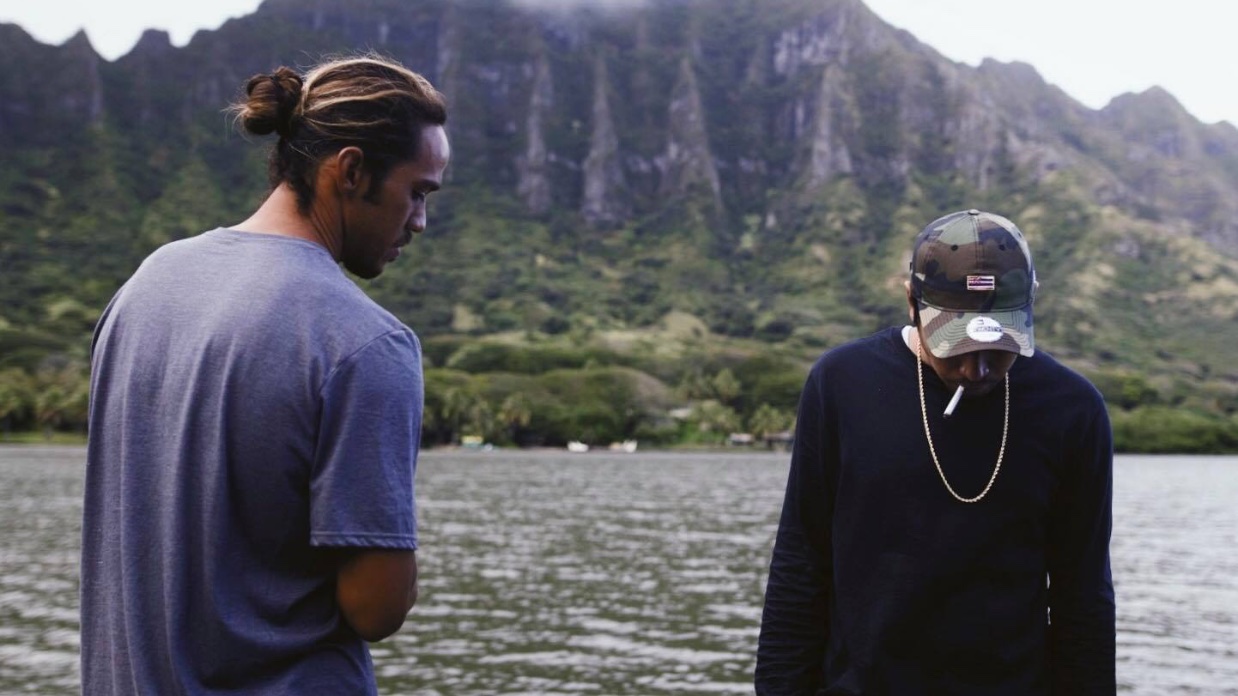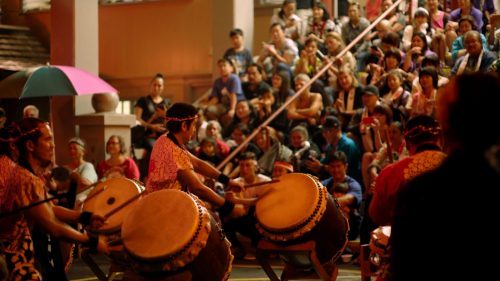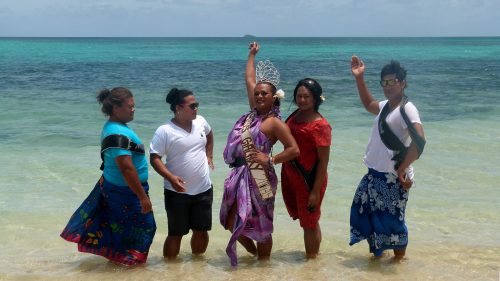 Back to selection
Back to selection
Made Visible: The 2018 Hawai’i International Film Festival
 Mauka to Makai
Mauka to Makai A question like whether a film festival should be considered “regional” or “international” in terms of outlook goes out the window when discussing the intriguing range of the Hawai’i International Film Festival Presented By Halekulani. Up until even a few years ago, the festival’s reputation was primarily that of a place to see the newest East Asian works; it offered a deep dive into established and emerging filmmakers, as well as various populist genres from China, Japan, and South Korea that tended to be overlooked Stateside. Works on Pacific Islander experiences and a few Asian-American independents rounded out the highlights, along with a handful of European arthouse titles. Two or three years ago, though, the festival also began to look locally as well, pointedly featuring and spotlighting local Hawai’ian filmmakers as well as other works spanning Pacific Islander cultures and communities. This year’s 38th edition, held in Honolulu in mid-late November, continued the festival’s dual embrace of both the international, the national, and the local. Much-anticipated appearances by Hong Kong director Wong Kar-wai, Korean actress/filmmaker Moon So-Ri, Japanese heartthrob-turned-filmmaker Takumi Saitoh, and New York’s own rising star Awkwafina lent the fest a buzz that wouldn’t have been out of place in Toronto or Tribeca, while its continuing support of the local scene came to fruition with a diverse range of narratives, documentaries, and shorts, including several honed through the Ohina Filmmakers Lab, a newly developed workshop and fellowship program created by several veterans of the local TV and film scene. “It was truly empowering to see how local filmmakers are utilizing the medium to open up real discussions,” noted director Jonah Okono (Mauka To Makai), “and to tell narratives from a perspective that we’re not used to in mainstream media.”

More reminiscent of the rhythms of Hou Hsiao-hsien, Apitchatpong Weerasethakul, or Nicolás Pereda than of commercial Hollywood filmmaking, Christopher Makoto Yogi’s August At Akiko’s‘s turns its loose storyline — a New York City avant-garde jazz musician (Alex Zhang Hungtai, of Dirty Beaches) returns to the Big Island after years away, and basically hangs out for awhile — into the cinematic equivalent of a summer’s breeze. Here, time slips away as effortlessly as the character’s days, with Makoto Yogi as hopeful of finding a kind of Buddhist calm through cinema as his character is through his sojourn. Observations of the natural world — sunlight through trees, a frog’s call at night, the depths of an ancient sea cave — mingle with those of the community around it, whether in the form of an elderly woman teaching Alex to play an Okinawan folk song, or an entire theater brought to life during a summer’s obon dance. Simultaneously blissful and joyous, becalmed yet full of life, August At Akiko’s channels a “slow-cinema” aesthetic into a pointedly Hawai’ian locale.
It may be unsurprising that the film premiered in Rotterdam, that capitol of challenging cinema, but its rapturous nature found just as receptive an audience back home, and proved that there’s space for a film whose rhythms are far more becalmed than the usual Hollywood fare. “To see that gorgeous sea of local faces in the theater was a dream,” said Makoto Yogi of the film’s homecoming. “And folks in Hawai’i are connecting with August on a very deep, personal level; I’ve heard again and again that people are moved by seeing their home portrayed in such a loving way.”
While much local narrative production still draws on a Hollywood or television approach to storytelling, August gives hope to a different way of “seeing” Hawai’i.” “Edison’s camera first arrived in Hawai‘i in 1898, the same year that Hawai‘i was illegally annexed by the U.S., and ever since, the moving image and colonization have really gone hand in hand,” notes Makoto Yogi. “As filmmakers in Hawai‘i, I feel that we have a deep responsibility to combat this image colonization not only in the stories we tell but also in our cinematic forms and processes. I’m really trying to find a cinematic grammar that is inspired by the land and the complex histories, cultures, and storytelling traditions of the islands.”
Makoto Yogi isn’t the only local filmmaker keeping the flame alive for more experimental, challenging approaches to narrative; Bradley Tangonan followed up last year’s award-winning short Wilder Palms with an atmospheric short portrait of a hula performer’s connection to the land, Kaumakaiwa, while Christopher Kahunahana (Lahaina Noon) worked a room of potential funders to help complete his first feature, Waikiki, a promising tropical-noir blend of documentary realism, island fantasy and social commentary. Kahunahana’s valiant effort to insert a more challenging, open-ended aesthetic into commercial filmmaking is both long-running (an earlier rough screening was mentioned in last year’s festival wrap-up) and illustrative of the difficulties filmmakers on the island face when it comes to finding enough funders. Grants and labs are one thing (both Makoto Yogi and Kahunahana participated in different Sundance Labs), but unlike Los Angeles or New York, the pool of individuals in Hawai’i looking to fund a film with a different way of “seeing” and “telling” simply seems much smaller, and with much less experience.
Further expanding the ways of seeing and sharing the multiple communities and stories of Hawai’i and beyond were this year’s documentary selections, including such well-crafted portraits as Aaron Lieber’s Made-in-Hawai’i Best Feature Winner Bethany Hamilton: Unstoppable, on the titular pro surfer, or Na’alehu Anthony’s Audience Award Winner Moananuiãkea: One Ocean. One People. One Canoe, on the around-the-world voyage of the famed Hawai’ian vessel and its primarily indigenous crew. Back on land, the Hawai’i Women in Filmmaking collective presented a timely omnibus of portraits of women filmmakers on the island, Reel Wahine of Hawai’i. A necessary corrective to the usually male-dominated hagiographies which clutter up most versions of history, cinematic or otherwise, Reel Wahine foregrounded the contributions of such ground-breaking image-makers and creators as Victoria Keith (whose 1979 work The Sand Island Story still stands as one of the greatest screen documentations of indigenous social activism ever made), Jeannette Paulson-Hereniko (founding director of HIFF, and still a vibrant presence there), and others. Most intriguingly, the producers made sure to allow a younger, emerging filmmaker to direct the profiles of their more established subjects to hopefully empower a new generation of creators. “We wanted to create a story with women at the center, not just a reflection,” tellingly stated Vera Zambonelli, one of the producers, during a Q&A. “In Hawai’i, we have a strong history of women behind the camera, including Native Hawai’ians and other women of color, who have never told their stories before,” Zambonelli wrote Filmmaker later. “We researched, recorded and disseminated this knowledge to counter the ways that academic and cultural histories regularly neglect women’s authorship and work in film and the arts in general. Sharing these films at the Festival meant to facilitate this conversation, and change the narrative.” Thanks to an NEA grant and the success of this first round of portraits, the Hawai’i Women in Filmmaking collective were able to start a second series as well, and continue to make visible the work of those too often overlooked.

Showcasing the overlooked and the invisible within its local and regional communities is one of HIFF’s great strengths (and should be the strength of any film festival). One of HIFF’s greater strengths, though, is the range of what defines its “local” community, with films from across Polynesia and the Polynesian diaspora coming under its umbrella thanks to Honolulu’s status as a regional landing pad for much of that diaspora. It’s over 3,100 miles from Honolulu to the Kingdom of Tonga, for instance (Seattle to Miami coast-to-coast is a mere 2,700), yet the festivals’ screening of Joe Wilson, Dean Hamer, and Hinaleimoana Wong-Kalu’s Leitis In Waiting may as well have been a hometown affair. A remarkable portrait of several Tongan transgender women (or leitis) led by the charismatic activist Joey Joleen Mataele, the film refreshingly gives its protagonists the space to speak for and about themselves. From the giddy flamboyance of crowd-pleasing beauty pageants or the everyday drudgery of household chores, and the struggle to organize politically in the face of rising (and usually US-funded) homophobia and fundamentalism, Leitis proudly puts front and center a community rarely — if ever — seen onscreen before. A thematic follow-up to Wilson and Hamer’s earlier festival favorite Kumu Hina, this film was co-directed as well by that film’s subject, Hinaleimoana Wong-Kalu, who first connected Mataele with the two.
The film’s screening provided one of the festival’s more memorable experiences, with Mataele in person and a celebratory audience comprised of many Polynesian “third-gender” individuals, from Tongan leitis to Hawai’ian mahu to Samoan fa’afafine. At one point Mataele and some friends took the stage for a performance and dance, with joyful audience members rushing up to shower the dancers with money or simply singing and clapping along. “Our experience at this year’s HIFF was wonderful,” writes Wilson of their screening. “Even though we live in the middle of the Pacific, stories reflecting the indigenous culture and diversity of our islands are often overlooked. HIFF provides a wonderful antidote by highlighting films that focus on the often overlooked people and communities who make Hawai’i and Polynesia unique….Also, there just seems to be an air of excitement around the programming and among the attendees that is at an even higher level than usual, and it’s infectious.”
Creating a full narrative or documentary feature may be beyond the reach of most emerging filmmakers, but HIFF’s Made in Hawai’i selection of short films proved that the talent is there, just waiting for a chance. Many were shepherded through the 2018 Ohina Filmmaker’s Lab, a new fellowship program (and offshoot of the long-running Ohina Short Film Showcase) created by veterans of the local television and film industries. The program offers local filmmakers a chance to polish their scripts through collaborations with established Hollywood screenwriters; last year’s mentor was Joe Robert Cole, co-screenwriter of Black Panther, while this year’s was Eric Pearson, co-writer of Thor: Ragnarok. There’s a theme there that’s both exciting and somewhat limiting, of course; the great aspect is that Ohina was created by TV and film industry veterans, and gives the chance to learn from Marvel superhero writers; the restrictive aspect is that Ohina was created by TV and film industry veterans, and gives the chance to learn from Marvel superhero writers. (Hopefully in the years to come, mentors from storytelling backgrounds beyond the Hollywood blockbuster will be chosen, but one can’t fault the Ohina crew for wanting to debut with more eye-catching names.) For Alika Maikau of Mauka to Makai, “the opportunity to seek council from a person of that stature was transformative – that ‘Ohina has setup an infrastructure to enable this exchange is a testament to the strength of their program, which will invariably lead to the growth of the next wave of local filmmaking.”
.
This year’s selections offered an array of intriguing, surprisingly — or unsurprisingly — polished narratives, ranging from science-fiction epics (!) to period pieces to more intimate family dramas. Boasting definitely-ready-for-prime-time special effects and some stellar acting talent, Mitchel Viernes’ Kalewa followed a Native Hawai’ian astronaut on a doomed journey to another star, and his flashbacks to family and friends at home. Merging the epic with the familial (and unabashedly aiming for both the stars and the heartstrings), its steady directorial hand and eyecatching art design served as a nearly faultless commercial calling card for what Ohina hopes to accomplish. Turning to the past rather than the future, Ty Sanga’s Hae Hawaii takes place in 1893, as a young Hawai’ian thief finds himself swept up in the illegal American overthrow of the Hawai’ian monarchy, with a chance to take back one of the only things left of his nation: its flag. A passion project for Sanga (one of the fellowship’s more established filmmakers), Hae Hawaii offered a more straightforward narrative approach, yet at least merged it with a proudly Hawai’ian tale of resistance.
Winner of the Second Prize in HIFF’s Made in Hawai’i shorts program (note: this writer was also one of the jury members), Erin Lau’s finely tuned The Moon and the Night was yet another graduate of the Ohina Filmmaker’s Lab. A precise, condensed telling of one young woman’s difficult realization that in order to save her family, she must stand on her own, the film stood out for its quieter line of filmmaking, worlds away (both cinematically and literally) from the blockbuster noise of the Marvel Universe. Basically a two-hander between emerging actors Bella Shepard and Jason Quinn, The Moon and the Night strips cinema down to the essentials of acting, mood, and setting.
All the films in the Made in Hawai’I Competition had their own strengths and visions, but Jonah Okano and Alika Maikau’s Mauka to Makai stood out for its loyalty and commitment to its specifically Hawaiian location and community and for its ability to swerve close to Hollywood style without actually losing its individuality. Bringing to the screen a world little seen even in Hawaiian films, it wove a universal tale of economic struggle and longtime friendship into a proudly local, indigenous setting, that of the rural Oahu region of Kāneʻohe. Mauka’s set-up is the classic tale of two friends, one going straight, the other still a bit crooked, and their long day-into-night journey of either self-awakening or, well, just waking up to do the same thing again. Okano and Maikau put directors with far larger budgets to shame as they deftly juggle various Hollywood young-adults-in-peril tropes, like music-video-like montages and the inevitable party scene, but for this reviewer what stands out more is their courage to stand down in the face of such slickness and instead focus on the natural world and the community that surrounds them. Refusing to stoop to either overdone Hollywood twists or the “poverty porn” gaze of an outsider, the film instead focused on the day-to-day financial struggles and decisions of those caught between barriers both economic and physical, as the film’s attentive framing of its spectacular natural landscape made clear. Kāneʻohe, a sliver of land stuck between the cliffs on one side (mauka) and the ocean on the other (makai), serves as an eye-catchingly distinctive natural metaphor for those stuck with nowhere to go.
“Screening Mauka at the Hawai’i International Film Festival was a surreal experience,” recalled Okano later. “It was truly empowering to see how local filmmakers are utilizing the medium to open up real discussions about relatable issues in Hawai’i, and to tell narratives from a perspective that we’re not used to in mainstream media. Mauka in particular is very specific to where it is set, so being able to screen to a local audience and hear the live reaction was overwhelming.”
“It’s a beautiful, bountiful time for Hawai’i filmmaking, as indigenous voices are being empowered and emboldened through vital platforms like HIFF and ‘Ohina, enabling us to wield control of the apocryphal image of Hawai’i that’s been marketed in the mediascape for decades,” notes Okano’s creative partner, Maikau. “The capacity to exert our voices into this narrative has finally caught up with our long-standing capability to do so — we’re telling our own stories now, with alacrity, and aloud.” Whether subverting the traditional Hollywood style for their own needs, or seeking out new ways of telling stories and fashioning narratives, the film scene in Hawai’i continues to grow in range and diversity, with HIFF playing an essential part in foregrounding communities and cultures that have long been overlooked and underseen. “To share these films with our audiences here in Honolulu offered the possibility to show that change is in the making here,” stated Zambonelli. Even the simple act of appearing onstage, invited to a festival to share your story, to make yourself and your community seen, marks an essentially political act. From Tongan leitis to veteran yet too often unnoticed women image makers, to young indigenous filmmakers showcasing their first short, “we were all there on stage, answering Q&A’s with the audience. We were there, visible.”
